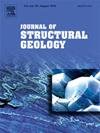The 3D model and growth pattern of the Longquan Shan fault zone in Sichuan basin, China: Implications for the potential earthquake rupture patterns
IF 2.9
2区 地球科学
Q2 GEOSCIENCES, MULTIDISCIPLINARY
引用次数: 0
Abstract
The fault three-dimensional (3D) structure and growth pattern are fundamental features of an active fault, which provide basic parameters for seismic hazard analysis. The Longquan Shan Fault Zone (LQFZ) is a major active fault, stretching for 200 km in the Sichuan Basin, southwestern China. In this study, we obtain a new, detailed 3D structure model of the LQFZ based on 43 high-resolution seismic reflection profiles. We further quantify the fault heave distribution along the entire LQFZ to understand its growth pattern. We find that the LQFZ contains four major thrust faults and a shallow detachment layer. We obtain 106 displacement values from the seismic profiles and 1963 heave values from the 3D structure model. The heave distribution of the LQFZ contains multiple peaks, indicating that the LQFZ is formed through the linkage of multiple fault segments. The cumulative heave profile of the four faults seems like an isolation fault, which implies the LQFZ has grown coherently since its formation. The maximum displacement and fault length of the four thrust faults show a linear scaling relation, suggesting that the faults grow in a self-similar manner. We also analyze the potential earthquakes on the LQFZ based on the 3D fault model and the fault growth pattern.
四川盆地龙泉山断裂带的三维模型和生长模式:对潜在地震破裂模式的启示
断层三维结构和生长方式是活动断层的基本特征,为地震危险性分析提供了基本参数。龙泉山断裂带是中国西南部四川盆地的一条主要活动断裂,全长200公里。在这项研究中,我们基于43个高分辨率地震反射剖面获得了一个新的、详细的LQFZ三维结构模型。我们进一步量化了整个LQFZ的断层隆起分布,以了解其生长模式。研究发现,该区发育4条主要逆冲断层和1个浅层滑脱层。我们从地震剖面得到了106个位移值,从三维结构模型得到了1963个隆起值。大断裂带的起伏分布包含多个峰,表明大断裂带是由多个断裂段联动形成的。4条断层的累计隆起剖面表现为孤立断层,说明LQFZ自形成以来一直是连续生长的。4条逆冲断层的最大位移与断层长度呈线性标度关系,表明断层发育具有自相似特征。基于三维断层模型和断层生长模式,分析了该区的潜在地震。
本文章由计算机程序翻译,如有差异,请以英文原文为准。
求助全文
约1分钟内获得全文
求助全文
来源期刊

Journal of Structural Geology
地学-地球科学综合
CiteScore
6.00
自引率
19.40%
发文量
192
审稿时长
15.7 weeks
期刊介绍:
The Journal of Structural Geology publishes process-oriented investigations about structural geology using appropriate combinations of analog and digital field data, seismic reflection data, satellite-derived data, geometric analysis, kinematic analysis, laboratory experiments, computer visualizations, and analogue or numerical modelling on all scales. Contributions are encouraged to draw perspectives from rheology, rock mechanics, geophysics,metamorphism, sedimentology, petroleum geology, economic geology, geodynamics, planetary geology, tectonics and neotectonics to provide a more powerful understanding of deformation processes and systems. Given the visual nature of the discipline, supplementary materials that portray the data and analysis in 3-D or quasi 3-D manners, including the use of videos, and/or graphical abstracts can significantly strengthen the impact of contributions.
 求助内容:
求助内容: 应助结果提醒方式:
应助结果提醒方式:


